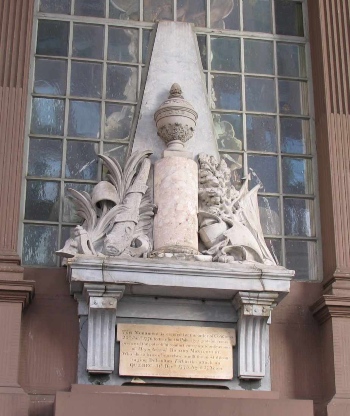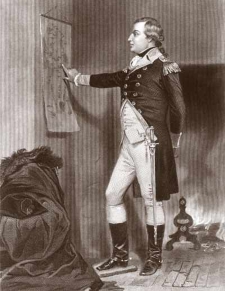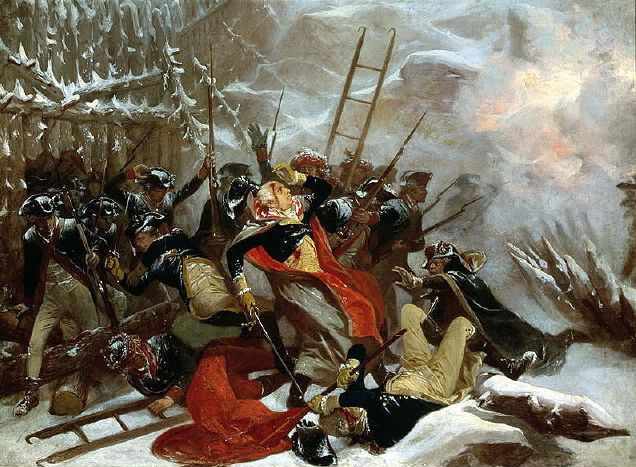General Richard Montgomery Monument Restoration
Current Events Post
April 19, 2011
 General Richard Montgomery Monument
General Richard Montgomery MonumentFULL RESTORATION TO BEGIN ON GENERAL RICHARD MONTGOMERY MONUMENT, THE NATION'S FIRST OFFICIAL MONUMENT, ERECTED TO HONOR GENERAL RICHARD MONTGOMERY WHO DIED AT THE BATTLE OF QUEBEC IN 1775
This Monument Celebrates the Heroism of General Richard Montgomery, the Fight for Independence, and the Perseverance of Benjamin Franklin.
General Richard Montgomery Monument
New York, NY (April 18, 2011) - America's first official monument is being disassembled, cleaned, restored and returned to its pedestal on the Broadway facade of St. Paul's Chapel where it has presided for 223 years, it was announced by The Rev. Dr. James Cooper, the 17th Rector of the Parish of Trinity Wall Street. The first full restoration of the General Richard Montgomery monument will take place onsite and is scheduled for completion later this summer.
"The parish of Trinity Wall Street has been a part of New York City's and our nation's history for over three centuries. St. Paul's and Trinity Church now draw more than 3 million visitors annually. As good stewards of our landmark properties, our obligation is to preserve the best of the past, engage the present and hopefully inform the future," Dr. Cooper said. "The restoration of America's first monument, commemorating the heroism of Major General Richard Montgomery in our nation's struggle for independence, is part of that process. It is also a lively chapter in our own history," he said.
The History
 General Richard Montgomery
General Richard MontgomeryThe marble and limestone Montgomery monument was commissioned by the Continental Congress in Philadelphia in January 1776, as reported in an appreciative treatise by Henry Kent, a former Secretary to the Board of the Metropolitan Museum of Art, writing in a 1929 Trinity publication. The memorial pays tribute to the valor of Major General Richard Montgomery, who died in December 1775 at the age of 37 leading a charge against a larger British force in the Battle of Quebec. The amenable Benjamin Franklin was entrusted to have a monument fashioned in France that would transmit "to future ages, as examples truly worthy of imitation, (General Montgomery's) patriotism, conduct (and) boldness of enterprise." For the purpose, Congress allocated "a sum not exceeding three hundred pounds" (comparable to the value of six of the 342 chests of tea dumped into Boston harbor).
Franklin, in Paris, engaged Jean-Jacques Caffieri, a renowned sculptor who worked on Versailles and according to Franklin, "is one of the best artists here." The completed work was shipped to Le Havre in 1777 in nine "strong" cases in preparation for the risky voyage to America. Caffieri complained about his fee and Franklin, while extolling "the beauty of the marble and the elegant simplicity of the design," noted that he (Franklin) had "to pay the additional charges of package."
According to Henry Kent, the pragmatic Franklin took precautions should the French ship become an enemy prize, writing to a connected British business friend, "If (the monument) should fall into the hands of any of your cruisers, I expect you will exert yourself to get it restored to us, because I know the generosity of your temper, which likes to do handsome things, as well as to make returns."
 Death of General Richard Montgomery on 31st December 1775 by Alonzo Chappel
Death of General Richard Montgomery on 31st December 1775 by Alonzo ChappelThe General Richard Montgomery Monument arrived safely, but not in Philadelphia. It was sent to Edenton, North Carolina, entrusted to Joseph Hewes, a signer of the Declaration of Independence, and considered by many the first Secretary of the Navy. The port of Edenton was one of the few remaining American held custom houses. And there the Montgomery monument lingered.
During this period, Franklin wrote to John Jay, then to Robert Livingston (Montgomery's brother-in-law) and again in 1786 to John Jay regarding the monument, asking "what is become of it?" He noted that in the opinion of some "republics are noticeably ungrateful... and letting the Monument lie eight years unpacked, if true, seems rather a confirmation of it."
While Franklin received no replies, unknown to him notice had been taken--perhaps in response to his earlier letter to Livingston--when a member of the New York Congressional delegation offered a resolution, which Congress adopted, for the monument to be sent from North Carolina to New York City. The New York State legislature adopted a similar resolution saying City officials should decide on its exact location. But still the monument did not move.
The leisurely bureaucratic pace seems finally to have been stirred by Mrs. Montgomery from her estate in Rhinebeck enlisting the aid of a prominent jurist and former governor of North Carolina to actually get the monument shipped. Ultimately, the monument was transferred to New York with St. Paul's being the unanimous site chosen by the City's Board of Aldermen, and the Trinity vestry agreeing in 1787 on the chapel's east wall window. The following year, as a side note, the city asked the state to repay the 171.7 pounds it had spent on erecting the monument.
The General Richard Montgomery Monument was installed by Pierre L'Enfant, who subsequently gained fame planning Washington, DC. L'Enfant also created a unique double-sided work of art at the rear, great window of the chapel. It functions as an altarpiece that blocks the view of the unfinished back of the Montgomery monument that could otherwise be seen by worshippers through the chapel window, and which also functions as a frame for the monument when viewed from the exterior. Interestingly, the frame contains post-Independence symbols, including a rising sun with thirteen rays and a bald eagle, draping the pre-Independence memorial.
Finally, in 1818, at Mrs. Montgomery's further request, the General's body was shipped from Quebec. The widow, standing on the balcony of her Rhinebeck home overlooking the Hudson, watched the steamer pass by, carrying the General to be re-interred at St Paul's, the monument becoming a tomb. An imposing funeral was held for General Montgomery with full military honors and choral music on July 8, 1818 - 43 years after his fatal assault on Quebec.
The RestorationThe baroque and rococo style marble and limestone monument depicts the General's virtues rather than his physical form. Various trophies symbolize liberty, strength, chivalry and martyrdom, and there are also carvings of a plowshare, a martyr's palm frond supporting a liberty cap, a Herculean club, an oak branch and a broken sword.
Time, the elements, cement, paint drippings and problems from corrosive agents used in early prior repairs have caused discoloration, cracks and surface deterioration. The full restoration, the first since its installation, will remove the drippings and corrosive agents, make repairs using sympathetic and compatible materials (including a version of 18th century grout), where needed replace missing marble and limestone from the same quarries (with the help of the present head architect of Versailles) and refresh painted areas.
Non-destructive cleaning and compatible repair methods will be employed to reveal and stabilize the original stone while an invisible coating will be applied in select locations to provide protection from the weather and harmful salts from bird droppings.
Glenn Boornazian, president and principal conservator of Integrated Conservation Resources, is undertaking the restoration for Trinity Wall Street. The General Richard Montgomery Monument restoration should be completed by the end of the summer.
Published 4/19/11
Revolutionary War and Beyond Home
Like This Page?
© 2008 - 2022 Revolutionary-War-and-Beyond.com Dan & Jax Bubis










Facebook Comments